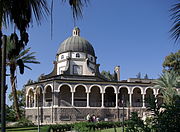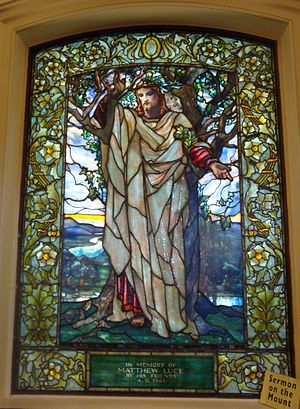
Sermon on the Mount
About this schools Wikipedia selection
SOS Children volunteers helped choose articles and made other curriculum material With SOS Children you can choose to sponsor children in over a hundred countries

The Sermon on the Mount is a collection of Jesus' sayings, which emphasizes his moral teaching found in the Canonical Gospel of Matthew, (see also the Hebrew Gospel or Matthaei Authenticum) . According to chapters 5-7, Jesus of Nazareth gave this sermon (estimated around AD 30) on a mountainside to his disciples and a large crowd. Matthew groups Jesus' teachings into five discourses, of which the Sermon on the Mount is the first. The others concern instructions for the disciples, parables of the Kingdom, instructions for the church, and a harsh denunciation of scribes and Pharisees.
The best-known written portions of the sermon comprise the Beatitudes, found at the beginning of the section. The sermon also contains the Lord's Prayer and the injunctions to " resist not evil" ( 5:39) and " turn the other cheek", as well as a version of the Golden Rule. Other lines often quoted are the references to " salt of the earth", "light of the world" and "judge not, lest ye be judged."
Many Christians believe that the Sermon on the Mount is a form of commentary on the Ten Commandments. It portrays Christ as the true interpreter of the Mosaic Law. To most believers in Jesus, the Sermon on the Mount contains the central tenets of Christian discipleship, and is considered as such by many religious and moral thinkers—such as Tolstoy, Gandhi, and Dietrich Bonhoeffer—, and it has been one of the main sources of Christian pacifism.
Location
There are no actual mountains in this part of Galilee, but there are several large hills in the region to the west of the Sea of Galilee, and so some scholars do not feel "the mountain" is the most accurate understanding of the Greek word used in Matthew 5:1. Gundry feels it could mean "mountainous region," while France feels it should be read as "the hills." Less clinical academic analysis amongst some modern Christians has suggested the location as a hill on the north end of the Sea of Galilee, near Capernaum. The area believed to be where the Sermon on the Mount took place is unique in that it is a natural amphitheater. From the top of the north-facing hillside, any voice spoken at regular level is amplified with enough volume for people within 200 yards to hear as though the speaker were standing beside them.

One possible location of the sermon is on a hill that rises near Capernaum. Known in ancient times as Mt. Eremos and Karn Hattin, this hill is now the site of a twentieth-century Roman Catholic chapel called the Church of the Beatitudes.
The reference to going up a mountain prior to preaching is considered by many to be a deliberate reference to Moses on Mount Sinai, and though Hill disagrees, arguing that the links would have been made far clearer, Lapide feels that the clumsy phrasing implies that this verse is an exact transliteration from the Hebrew passage describing Moses. Augustine of Hippo in his commentary on the Sermon on the Mount supported the Moses parallel, arguing that this symbolism showed Jesus as supplementing the precepts of Moses, although in Augustine's later writings, such as the Reply to Faustus, he carefully backs away from this view.
Comparisons with the Sermon on the Plain
While Matthew groups Jesus' teachings into sets of similar material, the same material is scattered when found in Luke. The Sermon on the Mount may be compared with the similar but more succinct Sermon on the Plain as recounted by the Gospel of Luke (6:17–49), which occurs at the same moment in Luke's narrative, and also features Jesus heading up a mountain. Some scholars believe that they are the same sermon, while others hold that Jesus frequently preached similar themes in different places. However, a number of scholars believe that at least one sermon never took place but was a conflation created by the author to frame the primary teachings of Jesus recorded in the Q document.
Structure
|
in the Gospels |
|---|
|
The sermon comprises the following components:
Introductory narrative (Matthew 5:1-2)
A large crowd is attracted by Jesus' healing of the sick. He climbs a mountain to address the crowd.
Beatitudes (Matthew 5:3-12)
They describe the character of the people of the kingdom. These are Christ's promises of coming blessings. In Matthew, there are eight (or nine) blessings, while in Luke there are four, followed by four woes. In Matthew, more than in Luke, the Beatitudes refer to moral or spiritual qualities of Christian discipleship.
Metaphors of Salt and Light (Matthew 5:13-16)
This concludes the picture of God's people drawn in the beatitudes, as well as an introduction to the following section.
Expounding of the Law (Matthew 5:17-48)
Jesus fulfills and reinterprets Mosaic Law and in particular the Ten Commandments, contrasting with what "you have heard" from others, also known as the Antitheses.
Discourse on ostentation (Matthew 6)
Jesus condemns the "good works" of fasting, alms, and prayer, when they are only done for show, and not from the heart. The discourse goes on to condemn the superficiality of materialism and call the disciples not to worry about material needs, but to "seek" God's kingdom first.
Lord's Prayer
Within the discourse on ostentation, Matthew presents an example of correct prayer. Luke places this in a different context. The Lord's prayer contains parallels to 1 Chronicles 29:10-18.
Discourse on judgmentalism (Matthew 7:1-6)
Jesus condemns those who judge others before first judging themselves.
Discourse on holiness (Matthew 7:7-29)
Jesus concludes the sermon by warning against false prophets, and emphasizing that humans are unable to do right ("bear fruit") apart from God. The Foundation must be on the Rock.
Interpretation

One of the most important debates over the sermon is how directly it should be applied to everyday life. Almost all Christian groups have developed nonliteral ways to interpret and apply the sermon. McArthur lists twelve basic schools of thought on these issues:
- The Absolutist View rejects all compromise and believes that, if obeying the scripture costs the welfare of the believer, then that is a reasonable sacrifice for salvation. All the precepts in the sermon must be taken literally and applied universally. Proponents of this view include Francis of Assisi, Dietrich Bonhoeffer and in later life Leo Tolstoy. The Oriental Orthodox Churches fully adopt this position; among Radical Reformation groups, the early Anabaptists came close, and modern Anabaptist groups such as the Mennonites and Hutterites come closest. More recently, this view is supported by Franz Alt and James W. Douglass.
- One method that is common, but not endorsed by any denomination, is to simply modify the text of the sermon. In ancient times this took the form of actually altering the text of the sermon to make it more palatable. Thus some early copyists changed Matthew 5:22 from "whosoever is angry with his brother shall be in danger of the judgment" to the watered-down "whosoever is angry with his brother without a cause shall be in danger of the judgment." "Love your enemies" was changed to "Pray for your enemies" in pOxy 1224 6:1a; Did. 1:3; Pol. Phil. 12:3. John 13:34-35 tells the disciples to "Love one another". The exception for divorce in the case of porneia may be a Matthean addition; it is not present in Luke 16:18, Mark 10:11, or 1 Cor 7:10–11; and in 1 Cor 7:12–16, Paul gives his own exceptions to Jesus' teaching. Additions were made to the Lord's Prayer to support other doctrines, and other prayers were developed as substitute. More common in recent centuries is to paraphrase the Sermon and in so doing make it far less radical. A search through the writings of almost every major Christian writer finds them at some point to have made this modification.
- One of the most common views is the Hyperbole View, which argues that portions of what Jesus states in the Sermon are hyperbole, and that if one is to apply the teaching to the real world, they need to be "toned down." Most interpreters agree that there is some hyperbole in the sermon, with Matt 5:29 being the most prominent example, but there is disagreement over exactly which sections should not be taken literally.
- Closely related is the general principles view that argues that Jesus was not giving specific instructions, but general principles of how one should behave. The specific instances cited in the sermon are simply examples of these general principles.
- The double standard view is the official position of the Roman Catholic Church. It divides the teachings of the sermon into general precepts and specific counsels. Obedience to the general precepts is essential for salvation, but obedience to the counsels is only necessary for perfection. The great mass of the population need only concern themselves with the precepts; the counsels must be followed by only a pious few such as the clergy and monks. This theory was initiated by St. Augustine and later fully developed by Thomas Aquinas, though an early version of it is cited in Did. 6:2, "For if you are able to bear the entire yoke of the Lord, you will be perfect; but if you are not able to do this, do what you are able" (Roberts-Donaldson), and reflected in the Apostolic Decree of the Council of Jerusalem ( Acts 15:19-21). Geoffrey Chaucer also did much to popularize this view among speakers of English with his Canterbury Tales (Wife of Bath's Prologue, v. 117-118)
- Martin Luther rejected the Roman Catholic approach and developed a different two-level system McArthur refers to as the two realms view. Luther divided the world into the religious and secular realms and argued that the Sermon only applied to the spiritual. In the temporal world, obligations to family, employers, and country force believers to compromise. Thus a judge should follow his secular obligations to sentence a criminal, but inwardly, he should mourn for the fate of the criminal.
- At the same time as the Protestant Reformation was underway, a new era of biblical criticism began leading to the Analogy of Scripture View. Close reading of the Bible found that several of the most rigid precepts in the sermon were moderated by other parts of the New Testament. For instance, while Jesus seems to forbid all oaths, Paul is shown using them at least twice; thus the prohibition in the Sermon may seem to have some exceptions; though in fairness to Paul, it should be pointed out that he was not present at the Sermon on the Mount and may not have been aware of all of its teachings. See also Pauline Christianity.
- In the nineteenth century, several more interpretations developed. Wilhelm Herrmann embraced the notion of attitudes not acts, which can be traced back to Augustine. This view states that Jesus in the Sermon is not saying how a good Christian should behave, only what his attitude is. The spirit lying behind the act is more important than the act itself.
- Albert Schweitzer popularized the interim ethic view. This view sees Jesus as being convinced that the world was going to end in the very near future. As such, survival in the world did not matter as in the end times material well-being would be irrelevant.
- In the twentieth century another major German thinker, Martin Dibelius, presented another view also based on eschatology. His unconditional Divine will view is that the ethics behind the sermon are absolute and unbending, but the current fallen state of the world makes it impossible to live up to them. Humans are bound to attempt to live up to them, but failure is inevitable. This will change when the Kingdom of Heaven is proclaimed and all will be able to live in a godly manner. A similar view is also described in Dostoevsky's The Brothers Karamazov, written in the late nineteenth century.
- Closely linked to this is the repentance view, which is that Jesus intended for the precepts in his Sermon to be unattainable, and through our certain failure to live up to them, we will learn to repent or that we will be driven to faith in the Gospel.
- Another eschatological view is that of modern dispensationalism. Dispensationalism, first developed by the Plymouth Brethren, divides human history into a series of ages or dispensations. Today we live in the period of grace where living up to the teachings of the sermon is impossible, but in the future, the Millennium will see a period where it is possible to live up to the teachings of the sermon, and where following them will be a prerequisite to salvation.
E. Earle Ellis (Professor of Theology at SWBTS) says that this sermon is an eschatological invitation in which Jesus is inviting believers to live according to an ethic that will be standard in the future kingdom of God. As Ellis says, we are to speak Jesus' words, think his thoughts, and do his deeds. Since this will be the ethic of the future kingdom of God, believers should go ahead and adjust their lives to this ethic in this age.


